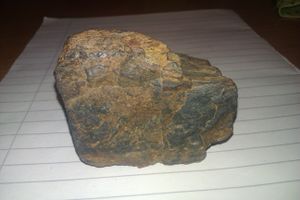Iron(II,III) oxide
 Magnetite sample
| |
| Names | |
|---|---|
| IUPAC name
Iron(II) iron(III) oxide
| |
| Other names
Black iron oxide, ferroso ferric oxide, ferrous ferric oxide, iron(II,III) oxide, iron(II) diiron(III) oxide, lodestone, magnetite, rust
| |
| Properties | |
| Fe3O4 FeO·Fe2O3 | |
| Molar mass | 231.533 g/mol |
| Appearance | Black solid |
| Odor | Odorless |
| Density | 5.0 g/cm3 |
| Melting point | 1,597 °C (2,907 °F; 1,870 K) (decomposition) |
| Boiling point | Decomposes |
| Insoluble | |
| Solubility | Reacts with acids, halogens Insoluble in organic solvents |
| Vapor pressure | ~0 mmHg |
| Hazards | |
| Safety data sheet | Sigma-Aldrich |
| Flash point | Non-flammable |
| Lethal dose or concentration (LD, LC): | |
| LD50 (Median dose)
|
5,000 mg/kg (rat, oral) |
| Related compounds | |
| Related compounds
|
Iron(III) oxide |
| Except where otherwise noted, data are given for materials in their standard state (at 25 °C [77 °F], 100 kPa). | |
| Infobox references | |
Iron(II,III) oxide, also known as ferrous ferric oxide, black iron oxide, or mineral magnetite, is an iron oxide with the chemical formula Fe3O4.
Contents
[hide]Properties
Chemical
Magnitite can be calcinated in air to yield iron(III) oxide:
- 2 Fe3O4 + ½ O2 → 3 Fe2O3
Iron(II,III) oxide can also be used as source of iron oxide in thermite reactions.
Physical
Iron(II,III) oxide is a black compound, insoluble in water, but reacts with acids. It is ferrimagnetic and an electrical conductor.
Availability
Black iron oxide is available as pigment in pottery shops and can be cheaply purchased.
Purer magnetite can be bought online from chemical suppliers.
It also occurs naturally as the mineral magnetite.
Preparation
There are several ways to prepare magnetite. One method involves the reduction of nitrobenzene with metallic iron and water, in the presence of iron(II) chloride, process that reduces the nitrobenzene to aniline. It can also be done by precipitating iron(II) salts as hydroxides, then carefully oxidizing the resulting iron(II) hydroxide at controlled pH.
Black iron oxide can also be prepared by oxidizing iron(II) hydroxide with water, in an oxygen-free medium.
- 3 Fe(OH)2 → Fe3O4 + H2 + 2 H2O
This process is known as Schikorr reaction.
Another method of producing this oxide is burning iron wire in oxygen.
- 3 Fe + 2 O2 → Fe3O4
This reaction may also give other iron oxides.
Projects
- Thermite
- Water-gas shift reaction catalyst
- Mineral collecting
Handling
Safety
Black iron oxide is not particularly toxic, unless large amounts are consumed. Inhalation of finely powdered magnetite may lead to lung conditions.
Storage
Iron(II,III) oxide should be stored in closed containers, away from acidic vapors. Any clean plastic container can be used.
Disposal
As iron(II,III) oxide occurs naturally, it is not harmful to the environment and can be useful as an iron supplement for soil.